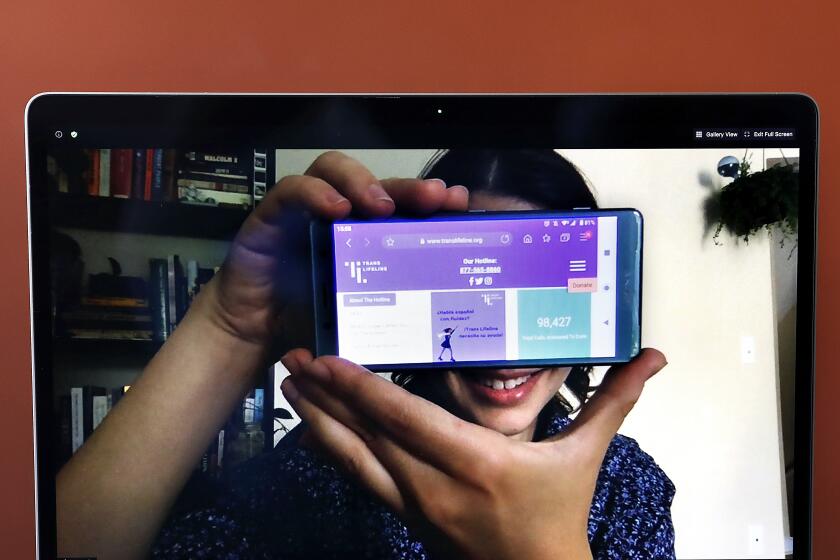‘From the trans community for the trans community’: LGBTQ center kicks off virtual Trans Pride OC
- Share via
When the LGBTQ Center of Orange County threw together its first Trans Pride OC event, the goal was to create a sense of community and visibility. Five years later, the original purpose remains the same.
But the center’s trans committee has to face one of the many challenges of the pandemic era: How do you translate community and visibility in the virtual realm?
This year’s Trans Pride OC kicks off on Sept. 12 and continues on two additional Saturdays through the rest of the month. The event theme changes every week from love, education to awareness.
The three-day event is a mix of workshops in which speakers discuss dating and health, panel discussions highlighting nonbinary and Black trans experiences as well as keynote speakers like Netflix’s “The OA” Ian Alexander, Project Q’s Madin Lopez, Transitional Wisdom’s Nash Azarian and actress and activist Blossom Brown.
Artists, including writers, poets, painters and musicians, plan to perform live while some may be prerecorded. Poet Natasha Corich, DJ Unsheikable and DJ Lazyeye are some of the local featured artists.
The resource fair, usually packed with organizations’ spokespeople tabling at the event, is online in a list format. It includes doctors who have their own practice and specialize in gender-affirming medical transitions, makeup artists, advocacy groups, LGBTQ-owned businesses, religious and spiritual practices and more.
Trans Pride is traditionally held on the last Saturday of July but was postponed to September in the hopes that the event could be held in person.
“We’ve viewed pride as a big festival and a big party,” said Tony Viramontes, the center’s director of prevention services. “Our pride is slightly different and incredibly unique because it’s about bringing people together. It’s about us learning together. It’s about us growing together and it’s about us being visible together.”
In six years, the Trans Lifeline has answered more than 65,000 calls from people seeking support and solace from across the globe.
After it became clear an in-person event wouldn’t be possible, healthcare and transgender services coordinator Miliana Singh said the committee looked toward the center’s previous virtual events for inspiration. The LBGTQ Youth Convening conference led by Youth Empowered to Act was scheduled on Zoom over three consecutive Saturdays in May. About 500 people participated in the virtual conference, while last year’s in-person event garnered about 200.
One of the major differences is the loss of the event’s staple feature — the glam closet. In previous years, community partners would donate clothing, chest binders and hygiene products. Staff would spend about four days folding clothes and building racks to create a boutique free-for-all.
“People would come and take as many clothes as they wanted and match their gender identity,” Viramontes said. “It was really important, but it was also providing support to those individuals who maybe couldn’t afford to buy clothing. We noticed that it was serving the trans community, but it was also serving other branches of the LGBTQ community who are economically challenged.”
Singh said there’s nothing like it. She’s participated in organizing the event for three years and remembers seeing an 11-year-old, who attended Trans Pride with the child’s dad, getting a haircut and (for the first time) a chest binder. She saw the dad get emotional and cry.
“I think that was one of the beautiful things about the services that the center offers — the ways in which we can positively impact community and how people can finally feel heard and get the things that they’ve always needed” Singh said.
The center is in the planning phase of a creating videos with local partners, such as how-to tutorials on binding, bra-sizing, tucking and packing.
The origins of Trans Pride OC are steeped in closing a gap in needs specific to the trans community.
“The gap in services that intentionally target the trans community is incredibly wide in every part of the world, in every county you go to in the U.S.,” Viramontes said. “I would argue it’s probably higher and greater in Orange County given the climate that exists, what I mean is, it’s incredibly conservative.”
Major discrepancies in services include access to general healthcare as well as gender affirming services in HIV care, medical transitions and mental wellness.
Out of 3 million HIV-testing events reported to the CDC in 2017, the percentage of trans people who received a new HIV diagnosis was three times the national average with Black transmen and transwomen receiving the highest percentage of diagnosis.
A 2015 survey conducted online of 27,715 trans people in the U.S. found that 40% had attempted suicide in their lifetimes, which is eight times the rate of the general population.
Silvia Lilly, who represents National Alliance on Mental Health (NAMI) and is also a peer mentor, has seen an uptick in phone calls during the pandemic. The free peer-led NAMI connection program is phone-based, and callers are paired with a trained mentor who has lived experience.
Lilly said many of the artists, who were curated from the previously canceled NAMI Loud & Proud Festival, will take time to offer testimony about their own mental health journeys and how it connects to the arts.
“It’s very powerful [that it’s] September, which is mental health awareness month, and looking at the community at large … With this year being so heavy, those numbers have probably risen,” Singh said. “And I know that numbers seem to go down when both people are being affirmed and supported.”
Two of the event workshops on Sept. 19 are healthcare focused such as “Queering Health with UCI Gender Diversity Program.” The workshop will feature UCI Gender Diversity Program Coordinator and the center’s board member Brit Cervantes leading an open Q&A session with a medical provider. The goal is to demystify trans care — something Cervantes said isn’t easily available with a simple Google search.
“Historically and ongoing, there tends to be this idea that the T in LGBTQ is silent,” Cervantes said. “Just because there are a lot of increases in LGBTQ rights doesn’t necessarily mean that there are things that have been expanded or increased in terms of protections for trans folks.”
Recently, a federal judge blocked the Trump administration from enforcing a regulation rolling back trans healthcare protections, and the Department of Housing and Urban Development is proposing a rule that would allow emergency shelters to discriminate against transgender people.
In 2015, when the Santa Ana-based LGBTQ center had some funding available, it hired a part-time trans services coordinator, Dannie Ceseña. The first Trans Pride OC event was organized in about two weeks by Ceseña, Viramontes, Cervantes and the Cervantes family.
“We brainstormed about what we could provide for the community … and they had this great idea. It’s beautiful to see that it really came from the trans community for the trans community,” Viramontes said.
The first event had a handful of workshops, and the resource fair fit in the center’s patio with about 80 attendees showing up.
It was the first Trans Pride event for Cervantes, who uses the pronouns they, them and their, and it coincided with their birthday. The event was held around the same time period they came out as trans publicly. Cervantes attended the event with their family and remembers being ecstatic about the turnout.
Every year since then, the center’s trans services and the event have expanded. In 2019, there were about 500 attendees and 40 organizations that participated in the resource fair.
Cervantes said they are hoping about 1,000 attendees will be able to join, and one of the benefits of the virtual format is to have a wider reach.
“[Nearly] 50 years after the center was incorporated, we remain intentional and even more purposeful now than ever to bring community and provide visibility, but also expand beyond Orange County and provide that kind of support and community at a national level for those who need it,” Viramontes said.
All the latest on Orange County from Orange County.
Get our free TimesOC newsletter.
You may occasionally receive promotional content from the Daily Pilot.





